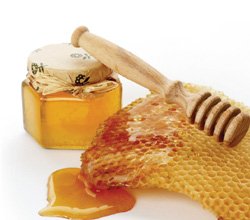
|

HONEY AND Honey Products
you are getting 100% natural , raw honey with no additives or preservatives.We also provide with all honey products.
Honey is a food source for honey bees . I n cold weather or when food sources are scarce, bees use their stored honey as their source of energy. Worker bees gather the fructose-rich flower nectar and return to the hive. In the hive they use their "honey stomachs" to ingest and regurgitate the nectar a number of times until it is partially digested. After the final regurgitation, it is stored in the honeycomb that is left open. Bees inside the hive fan their wings, creating a strong draft across the honeycomb which enhances evaporation of the water from the nectar. The reduction in water content, will prevents fermentation. Then the honey r ea ch es around 18% of humidity the bees will cap the honey comb. Honey is mainly fructose (about 38.5%) and glucose (about 31.0%) , the specific composition of any batch of honey will depend largely on the mix of flowers available to the bees that produced it. Honey has a density of about 1.36 kg/liter (40% denser than water).
our Typical honey analysis
Fructose: 38.0%
Glucose: 31.0%
Sucrose: 1.0%
Water: 17.0%
Other sugars: 9.0% (maltose, melezitose)
Ash: 0.17%
Other: 3.38%
1 tbsp = 21g = 64 cal
The pH of honey is commonly between 3.2 and 4.5. This relatively acidic pH level prevents the growth of many bacteria.
Honey is suitable for long term preservation and is easily assimilated even after long conservation. History knows examples of honey preservation for decades, and even centuries.
| Product Type: Honey | Form: Liquid | Processing Type: Raw, Pure, Mature |
| Brix (%): 00 | Packaging: Bulk | Weight (kg): 00 |